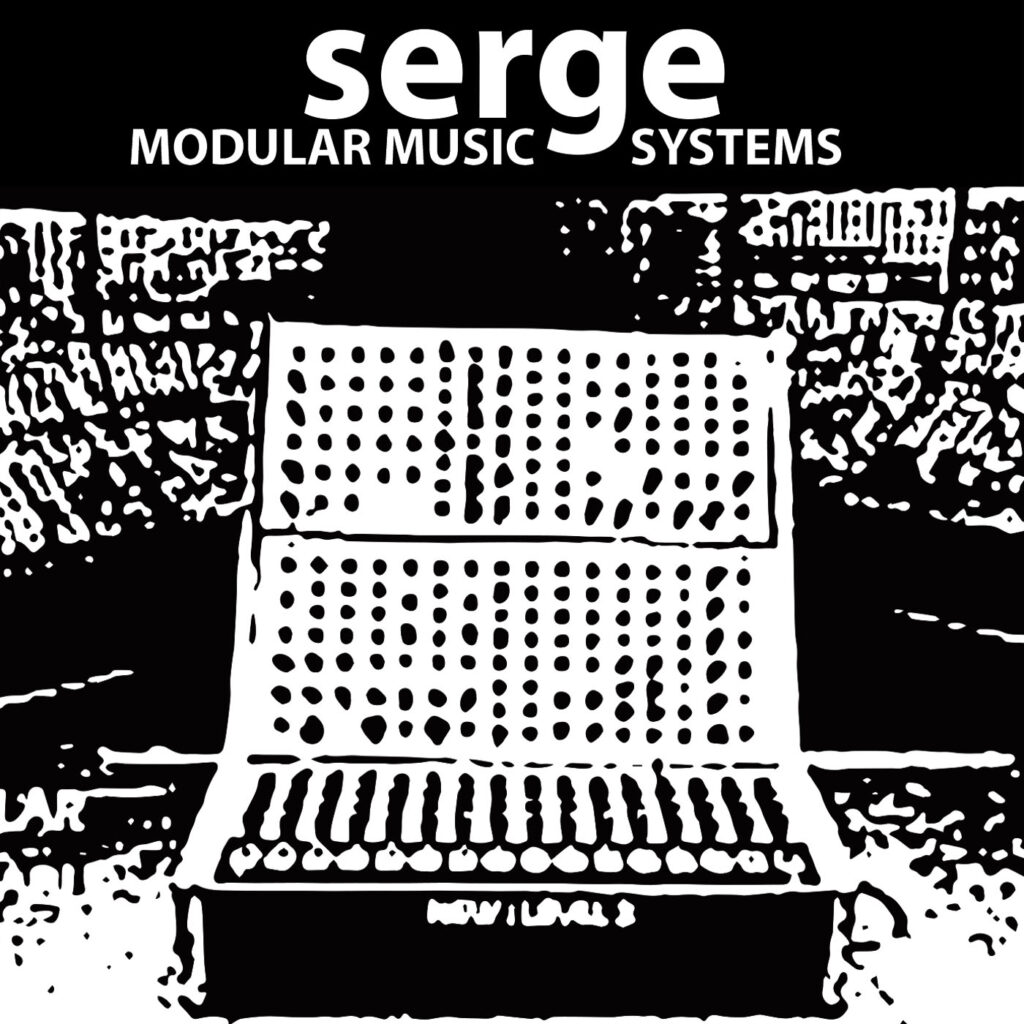“Serge-O-Vox :: Vox Populi :: the People’s Synthesizer” with Serge Tcherepnin by Philippe Petit
When I decided to start a series of portraits dealing with those who are designing modular instruments, inventing what allows us to sculpt our « plastic sounds » my first choice was BUCHLA because it is the brand which turned me on Modular Synthesis !!! Very soon I started to hear a lot of great things about SERGE Systems and started exchanging messages with Serge Tcherepnin who coined the term ITATIOM (Inventors Talking About Their Instruments Or Modules).
Serge Tcherepnin was born in Issy-les-Moulineaux and took first lessons in music with Nadia Boulanger and his father, Alexander Tcherepnin. His early life was spent travelling between France and the US, giving him a wide range of experiences – from being an assiduous fan of Boulez’s Domaine Musical concerts or of Parisian jazz (under the tutelage of Quincy Jones), and preparing the Paris Conservatoire (as a violonist) while also attending Harvard College and Princeton University studying music, the humanities and science. Self-taught in electronic design and circuitry, Serge Tcherepnin started experimenting with ‘junk electronics’ at an early stage, making tape compositions with repurposed transistor radios, etc… And to me, along with Don Buchla and David Cockerell they form the trio that initiated the best possibilities to experiment with modular synthesis.
Serge asked me if I’d use a text retracing his career as a synthesizer designer, as written by Chris Meyer from the excellent « Patch & Tweak » book he co-wrote with Kim Bjørn.
1968
Serge Tcherepnin moves to the US from Europe, where he finds one of his college friends is a member of the Pulsa Group at Yale University. “I quasi-joined them, spending time at their commune in Connecticut. (The Pulsa Synthesizer) gave a direction to my own future work, and not only on the technical level, but also humanly and aesthetically. Working cooperatively, people can roll their own highly technical projects on shoestring budgets.” The Pulsa synth to Serge was “a marvelous construction whose design made it impossible to emit anything resembling conventional music. (It) was materially incapable of performing a version of ‘Switched-on Bach’ or any disco type of thing.”
Later in 1968, Serge is invited by Morton Subotnick to join the Rockefeller-funded Intermedia Program at New York University. During this time, Serge designs and builds a variety of circuits for Mort and the other artists and musicians. “I had the run of Mort Subotnick’s studio containing Don Buchla’s 100 series synthesizer, and benefited from Don’s avowed policy of making his schematics open source. I learned a lot of my electronics from Don’s schematics, and they set me on the course that made my designs so different from everybody else’s.”
“What struck me upon examining Don’s designs, is how much very interesting stuff was hidden away in order to realize a given function. Take one of his VCOs for example. The VCO consisted of several blocks strung together, an sawtooth oscillator, a full wave rectifier producing a triangle wave, a diode shaper to turn the triangle into a sine wave, and a comparator circuit to produce pulse waves. All of it worked beautifully to make an elegant module, but so much of it was hidden, unable to be accessed, and very interesting stuff indeed. That’s why from the beginning, I determined to make sub-functions such as comparators, rectifiers, waveshapers, bi-directional routers, and peak and trough tracers available for use by the musician interested in sonic DIY.”
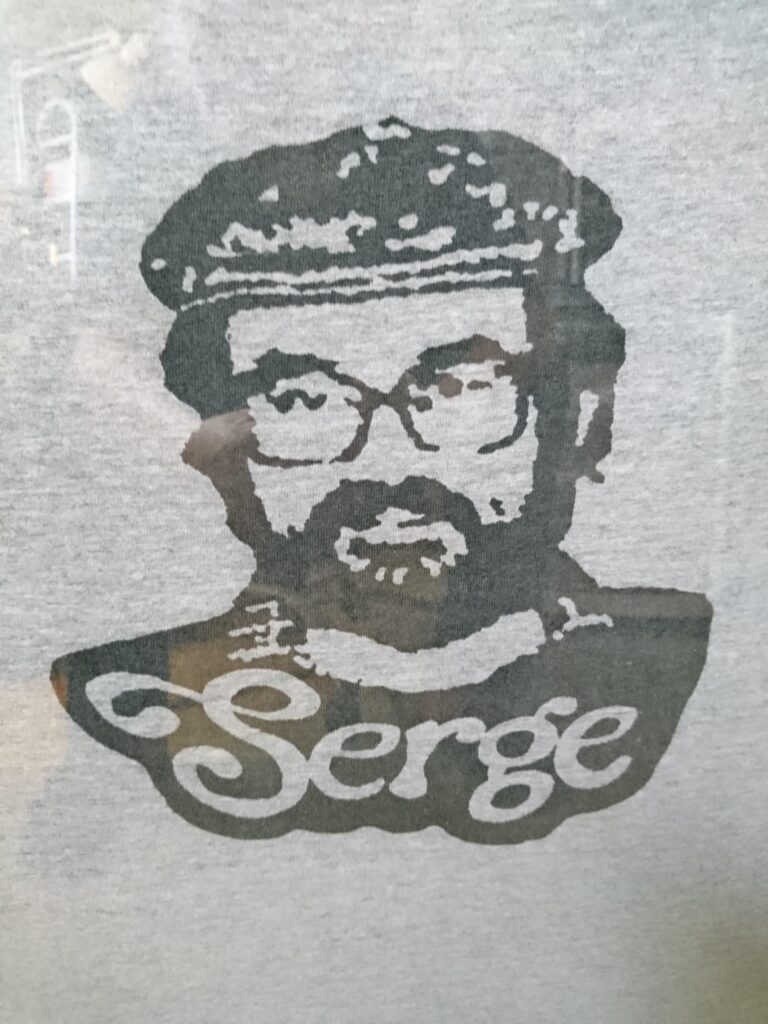
1970
Serge Tcherepnin joins the music faculty at the California Insititute of the Arts. There he sets up a lab for the design of circuits for use in the arts and music.
1972
Serge Tcherepnin teaches a workshop on a simple make your own modular synthesiser to summer school students. In the fall, he starts work on the design of a full fledged analog synth assisted by Randy Cohen and Rich Gold.
1973
Serge Tcherepnin gives the first ever demo of a complete Serge Modular Music System at the University of California in La Jolla “with quite a bunch of people – among them Max Matthews, Warren Burt, Mort Subotnick, Roger Reynolds, and Don Buchla. It must’ve mystified quite a few of the people there, as many of the modules were of functions unheard of in synths – modules such as the Positive and Negative Slew Generators, the Smooth and Stepped Generator, switchable Linear/Exponential VCAs, a VC controllable Ring Modulator, Triple Router, the Peak and Trough followers, Triple Comparator, the Analog Shift Register, and a state variable VCF that was a true advance in synth technology. Don Buchla took me aside after the show and kindly offered me his advice: ‘You know Serge, there’s no money to be made from manufacturing synthesizers.’”
Despite this, Serge decides to go ahead with his project for a “People’s Synthesizer,” offering a complete synth in kit form to the first twenty people willing to put up $600. The first group of subscribers – including Will Jackson (a founding member of Greenpeace) with band mates Mark Sprague and Chris Greulich, – “showed up with their $600, and over the summer and fall a group of about seven of us started building the synths on a balcony kindly lent to us by the Music Department at CalArts.”
“Soon enough, word of mouth of the project spurred interest from distant places. A few remaining synth kits from the first batch found institutional interest from Mills College, Harvard University, UC San Diego, and LaTrobe University. It became clear that Don Buchla’s dire warning was somewhat off the mark.” Serge ponders starting an actual company – a proposition Serge describes as “pigs might fly, especially considering that I refused an offer to work on the electronics for Star Wars to do this.” He rents a loft on Western Avenue in Hollywood, where a group of early adopters help him produce Serge synths, notable among whom two leading New-Age artists, Peter Robinson and Kevin Fortune Braheny, and film composers Gary Chang and Jill Fraser (p.xxx), later to be joined by Paul Young of Eazyteeth fame and Darrel Johansen who took on managing the business.
The original front panel graphics have primarily symbols in place of the usual technical terms. Designer Rich Gold explains his reasoning: “I wanted the Serge to look like an art piece, or a colorful visual score without explanatory writing – just as piano keys have no C, C#, D etc. written on their keys. Most of the other synthesizers of the era looked like medical equipment. What I designed was a series of meaningful, interlocking shapes that surrounded each hole and knob indicating its function and its use, visually.” As the purchaser could choose the arrangement of modules in a 16 inch wide panel, the graphics are printed on paper and arranged as needed, leading to the nickname ‘paper face’ for the early Serge synths. The paper labels are covered with a clear film, allowing the user to add notes using dry erase markers.
1976
Malcolm Cecil wants to retrofit his massive, mostly-Moog-based TONTO (The Original New Timbral Orchestra) with more stable oscillators, and taps Serge Tcherepnin for the job. Serge designs what becomes his NTO (New Timbral Oscillator), with voltage controlled waveshaping among other features. Serge is asked to mount his circuits behind black Moog-line panels in TONTO for “continuity.”
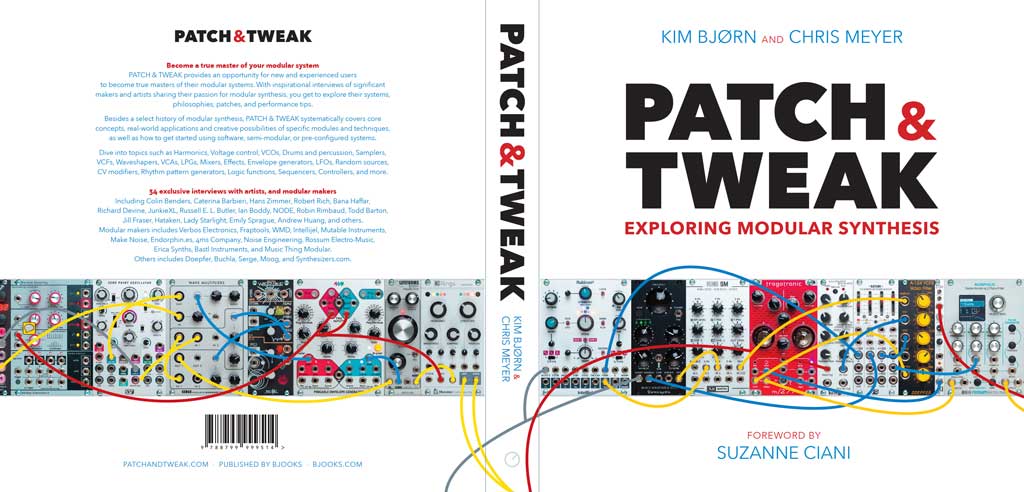
Serge ended designing modules for his company in 1984, moving from San Francisco to France in 1986, and licensing circuit designs and most equipment to a longtime associate Rex Probe who re-launched the business in the early nineties as Sound Transform Systems (STS) in Hartland, Wisconsin. Since then Serge Tcherepnin has licensed Serge Modular designs to various manufacturers, collaborating with them as a consultant. In 2015, Random*Source in Germany started working with Serge Tcherepnin on the series of Serge modules, both in classic 4U and Eurorack formats, combining the original circuits with the advantages of today’s technology. Random Source being de facto the « spiritual heir » recognized by the founder himself, it was important to give him the floor and that’s what we do by proposing, following that of Serge, an interview with Ralf Hoffmann.
Serge ’s career spans about 50 years so he may be the longest active designer in our art. His designs are celebrated and many younger designers emulate his work and deeply respect his legacy. More than by any other group of people, he’s been revered by the musicians that have used his systems for decades and by the new users who find them equally inspiring and productive today and form a real “Serge” community.
Where, when and how did you first become acquainted with modular synthesis? When did that happen? When did you build and/or design your first module?
In 68-69 when I was associated with the multimedia adventures of Mort Subotnick,the Intermedia Program at N.Y.U., the PULSA Group, the Electric Circus, PABLO Lights. I got very good at putting makeshift esoteric multimedia {light & sound) electronics together,though at the time I was operating from a personal background that included mostly music, physics, and surrealism but very little technology. I built things like proximity detectors,voltage controlled light dimmers, ring modulators, multiple tape recorder controllers, photocell sensors
How and When did you build your first modular synthesizer?
Actually, my first synthesizer predates any practical knowledge of electronics. It must have been in 1966 when I took apart transistor radios, and carefully analyzed points on the PC board traces which, when connected through photocells, capacitors, moistened fingers, made the most marvelous clicks, squeals and tones. In Germany, where I was at the time, they had ultra-mini multi-colored banana jacks, a dozen of which I installed into transformed transistor radios. Components and wires were patched in. My brother played many concerts using this primeval synthesizer. In retrospect I see that I was the 1966 avant-garde in the grand tradition of junk electronics (as named by the great video-art-musician Nam Jun Paik).
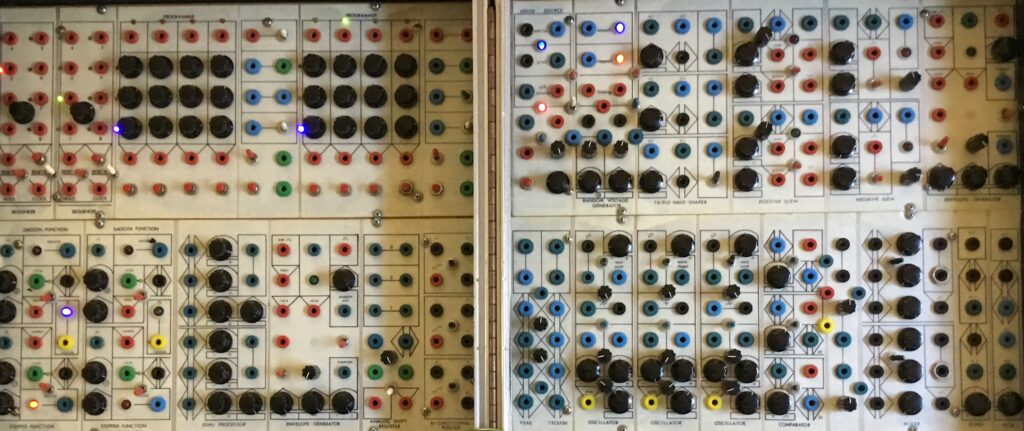
What was your view, at that time, of what a good synthesizer should do, and how does this compare with your present view on this subject?
A good synthesizer must provide opportunities to magic. I thought so then, and I think so now. It springs forth from the hands of the magician, of course. From this point of view, it follows that it’s also true, unlike what people think, that there is no such thing as obsolete musical electronics. Is there such a thing as an obsolete magic trick? I’ve carried this logic through for many years. I’ve always felt that it was important to keep perfecting the musician’s bag of tricks, not merely to exploit a module commercially whatever its flaws. Most modules in the Serge catalog are third or fourth generation designs reaching towards perfection.
What is your approach to the design of synthesizer modules? Do you usually start from a musical problem, or do you start from the electronics?
I’ve gone both ways, from music to the technology, and vice-versa. I remember the delight I had designing the Analog Shift Register, which was a module directly inspired by the concept of musical canon. But I like even better the modules which I designed upon thinking about electronic concepts. Electronics provides a marvelous escape to a frontier future, away from tired old aesthetics, tired old music. Being a quite re-tired composer, I speak from experience. Our catalog is full of modules which have no counterpart in conventional musical electronics, with names such as «Wave Multipliers» «Universal Slope Generators» , «Smooth and Stepped Generator». Electronic concepts fathered these modules, not musical considerations.
You have continued to focus your efforts on powerful generalized modular synthesizers while most of the industry has concentrated on normalled, keyboard-oriented instruments. What factors are responsible for this approach?
It goes back to what I was previously saying: electronics is the source of my designs, not public concepts of what music should or should not be. There’s nothing that delights me more than hearing Serge modules being used in unanticipated ways. Designing a keyboard synthesizer never seemed like much fun, because it means imposing a 12 note black and white key concept. If this concept were a Game of Life pattern, it would be very short-lived (as keyboard synthesizers have proven to be). I design modules which I add to an open-ended modular system. It’s up for a musician using this open system, to transform it into his or her own entirely individualized musical instrument.

Has the change in the center of gravity of electronic music, from the academic tape music studios of the late 60’s and early 70’s to the current widespread use of synthesizers in commercial and popular music, influenced your work?
Not one bit. I’ve never liked institutional studios, because I’ve never liked dealing with institutions. Les Paul, Jimmy Hendrix, Gordon Mumma, Richard Maxfield, Allan Bryant, DavidTudor, Karlheinz Stockhausen, Mort Subotnick, IvanTcherepnin, Nam Jun Paik, PULSA, E.A.T., John Cage, Marcel Duchamp, Tinguely, Dubuffet, Steve Reich, Max Neuhaus, Edgar Varese have been influences, however, in the sense that their work pointed to a personal use of technology. From the start, I tried making tools affordable so that people could construct personal studios. There should be economic parity, I feel, between a late model car and a well furnished electronic music studio. lmagine the world if .01% of this country’s garages housed personal music studios being revved up by happy music mechanics.
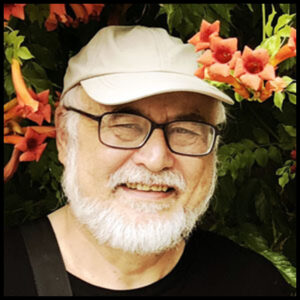
Are there any of your devices that posed especially difficult design problems? Are there any of which you are especially proud? Where, for example, you found a new or superior solution to a common problem?
Every difficult design problem awaits a breakthrough that makes its solution easy. Intractable,yes. Difficult, no. Yes,there are many designs of which I’m proud. I designed the very first 3080 based VCFs. I know that for a fact, because the batch of 3080s I got from RCA were such early devices that they had miswired pins (pins 2 and 3 were reversed!). I designed the world’s first single chip accurately exponential VCO which also included a voltage controllable waveform from sine to saw, in1973. I dare anyone to name the commercially available IC I did this design with, very common, very cheap. I later discarded the design because I desired better temperature stability. Actually, there are very few designs in the ten years that I’ve been working that did not involve creative solutions to common and uncommon problems. It wouldn’t be any fun, if electronics involved only pre-tested mechanistic solutions.
To what extent has your brother’s music affected the design of your instruments? Are there other composers whose requirements have influenced you?
My brother’s music was instrumental in making me want to get David Wilson’s «Analog Delay Module» into the Serge catalog, because Ivan’s music clearly showed what an amazing module it is. David and Ivan have long worked together at the Harvard electronic music studio. In general, however, I find that people’s music has had very little effect on the design of Serge modules. What has been influential, has been people’s needs. There are quite a few modules and features which owe their existence to someone saying that such and such function or feature would be useful in their work.
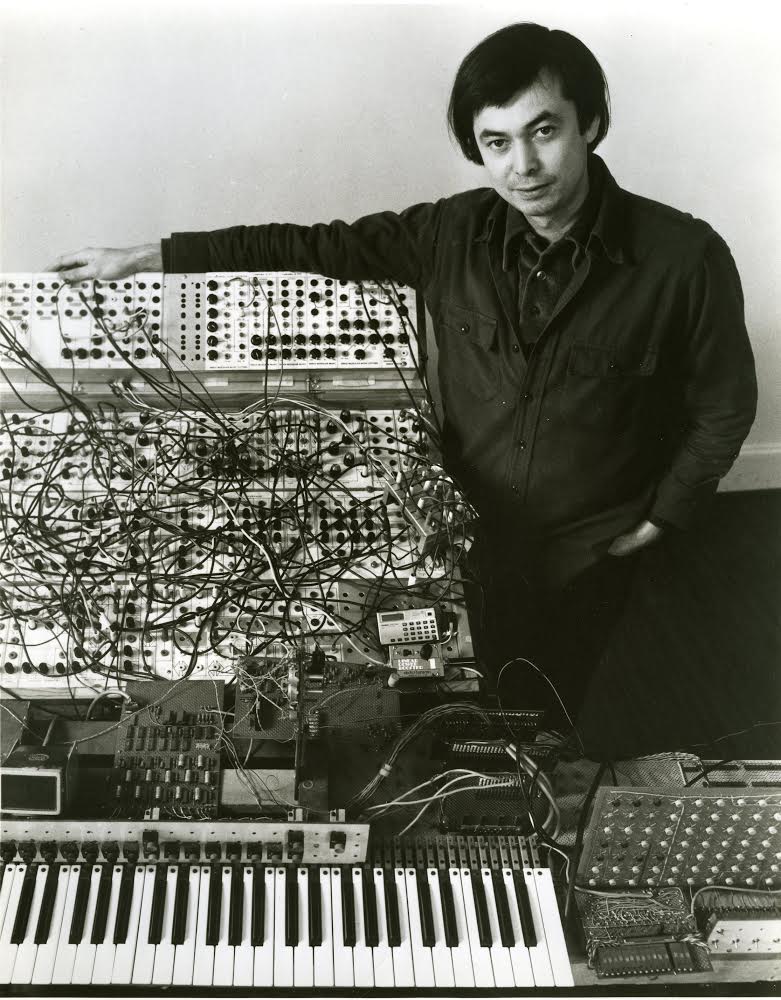
Which composers have made especially good use of your instruments? Are there commercial recordings on which your instruments are used in an exemplary manner?
We invited Serge owners to send in short pieces for a cassette to be used to demonstrate the system. The response was astonishing. There was not one trivial or inferior tape in the lot; they were all different musically.
My all time favorite favorites are :
« Santur Opera » by Ivan Tcherepnin
« Lullaby from the hearts of space » from Kevin Braheny Fortune
Also :
Randy Cohen
Patrick Thomas Küssner
Morley Robertson
Ingram Marshall – Fog Tropes / The East is Red
Yan Proefrock – Opus 3
Moebius and Doug Lynner
Thomas Ankersmit, Alvin Curran, Paul Young / Eazy Teeth, John Adams, Ingram Marshall, Earl Howard, Lyz Phillips, Michael Stearns, Warren Burt, Gary Chang, Jill Frasier, Jean Claude Eloy, Kent Sparling, Dmitri Bronson, Yvan Etienne, Rex Probe, Marc Canter, Peter Davison, Morley Robertson, Patrick Thomas Küssner, Christer Deman, Bernard Xolotl, Antonio Tuzzi, Alisa Clements, Sergei Tcherepnin, Stefan Tcherepnin, Mark Lenctzner, Nosrat Charkhi, Lars Arnwald, Ralf Hoffmann, Walter Wright, Ken Stone, John Wiggins, Joe Paradiso, Dean Santomieri, Naut Humon, Cynthia Webster, David Johnson, Eric Drew Feldman, Randy Cohen, John Bischoff, Andrew Raffo Dewar, Drew Schlesinger… André Stordeur, historically a major player in Belgium. Tom Hamilton and J-C Eloy, whose use of the serge is in the past was of high interest.…
What do you see as the future directions of your own work, of electronic music, and of music in general?
Let X=not X. Technology has a lot of catching up to do, if it’s to catch up with music, the arts, philosophy, maths, the sciences. Technology is a medium through which the many can palpably experience spaces explored by a few pioneers. Technologists like myself have a lot of puff and huffing ahead to hack away at computer languages, systems, modules, synthesizers, and make them behave. Rumor has it that the people best suited for programming fifth generation computers will be musicians, artists, mathematicians, meditators, and other right-brained endorphinated Jedi. We’ll see.
Here are 2 EXCLUSIVE videos from Zack Dagoba aka Ben Edwards:
+ Mark Lentczner playing « Dark Matter »
RESOURCES:
https://randomsource.net
Where they preserve and expand Serge’s inventive designs/ideas…
http://www.73-75.com
With the permission of Serge Tcherepnin, Jon Nensén (The Human Comparator) is offering his version of the iconic paper face modular system from 1973. All functions and appearances remains the same as it did 44 years ago.
https://www.youtube.com/watch?v=h19JrNXUrxs
The Serge Modular Synthesizer – History, Theory, and Application. An excellent presentation made by Nick Peck
https://www.youtube.com/c/DougLynner/featured
Doug Lynner’s You Tube channel offering infos and his « Patch of the week » series consisting of Modular synthesizer tips and tricks presented on the Mystery Serge modular synthesizer. Sure to become your favorite teacher !
https://www.elby-designs.com/contents/en-us/d58_ES_-_Euro_Serge.html
In partnership with Serge Tcherepnin and Ken Stone, Elby design are producing the EuroSerge family of synthesizer modules from the Serge Modular Music System and Doug Lynner helped them recreate his glorious « Mystery Serge » instrument…
http://www.metasonix.com/index.php/4u-modules-new
Metasonix is offering some great modules/ways to explore new directions in “Serge sound”
https://idmnyu.github.io/audiolab/serge.html
Valuable informations on the Serge system + The Shelfisizer which is an open-source project by Luke DuBois inspired by Serge modular systems but also hybrid analog synthesis / microcontroller systems such as the Buchla 200e.
http://www.serge-fans.com/history.htm
Serge fans webpage
Video interview by Waveshaper Media with Tcherepnin
Yan Proefrock made a documentary interview with Serge Tcherepnine reviewing the Serge Modular NEW TIMBRAL OSCILLATOR (NTO) by Random Source

